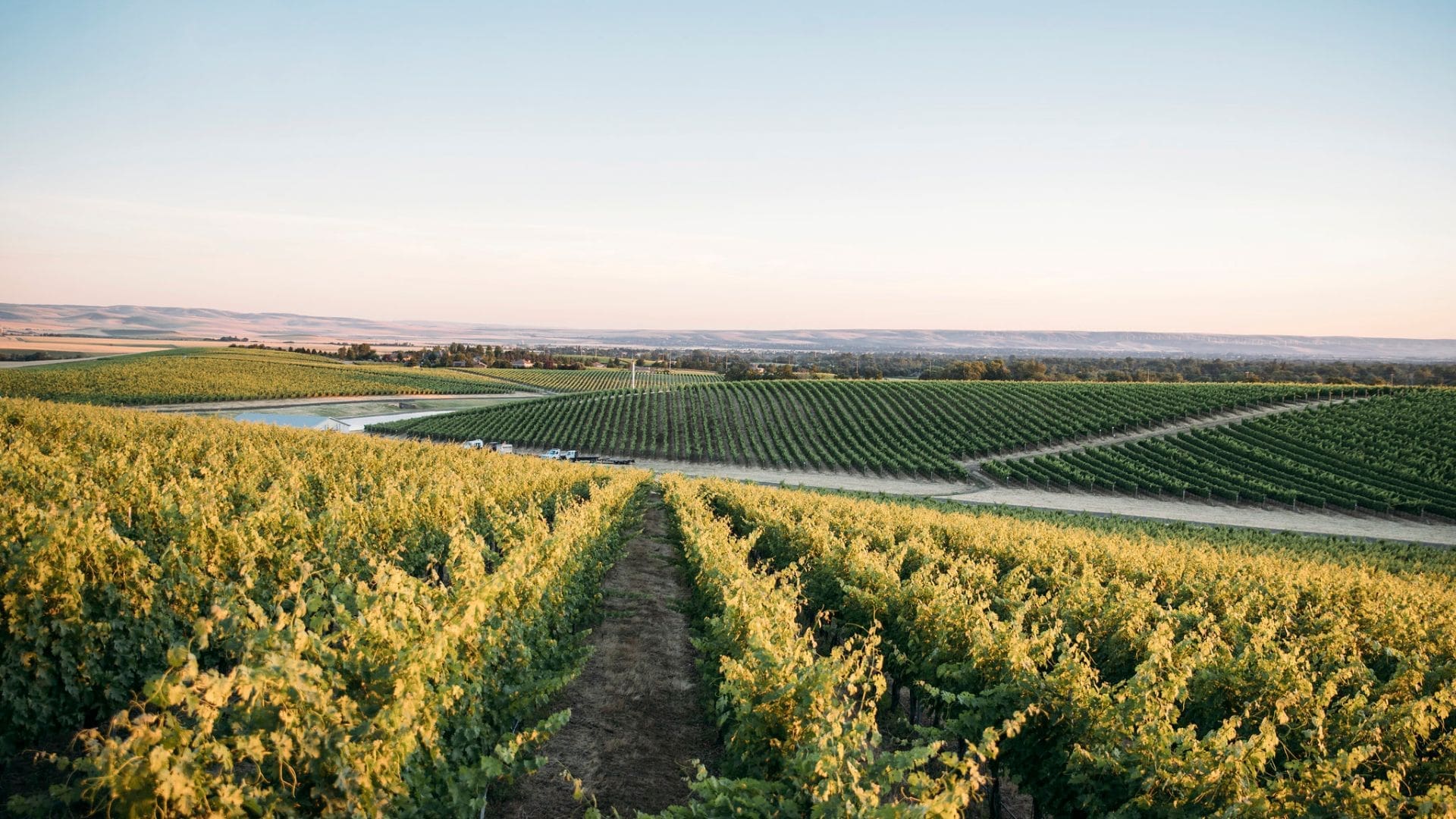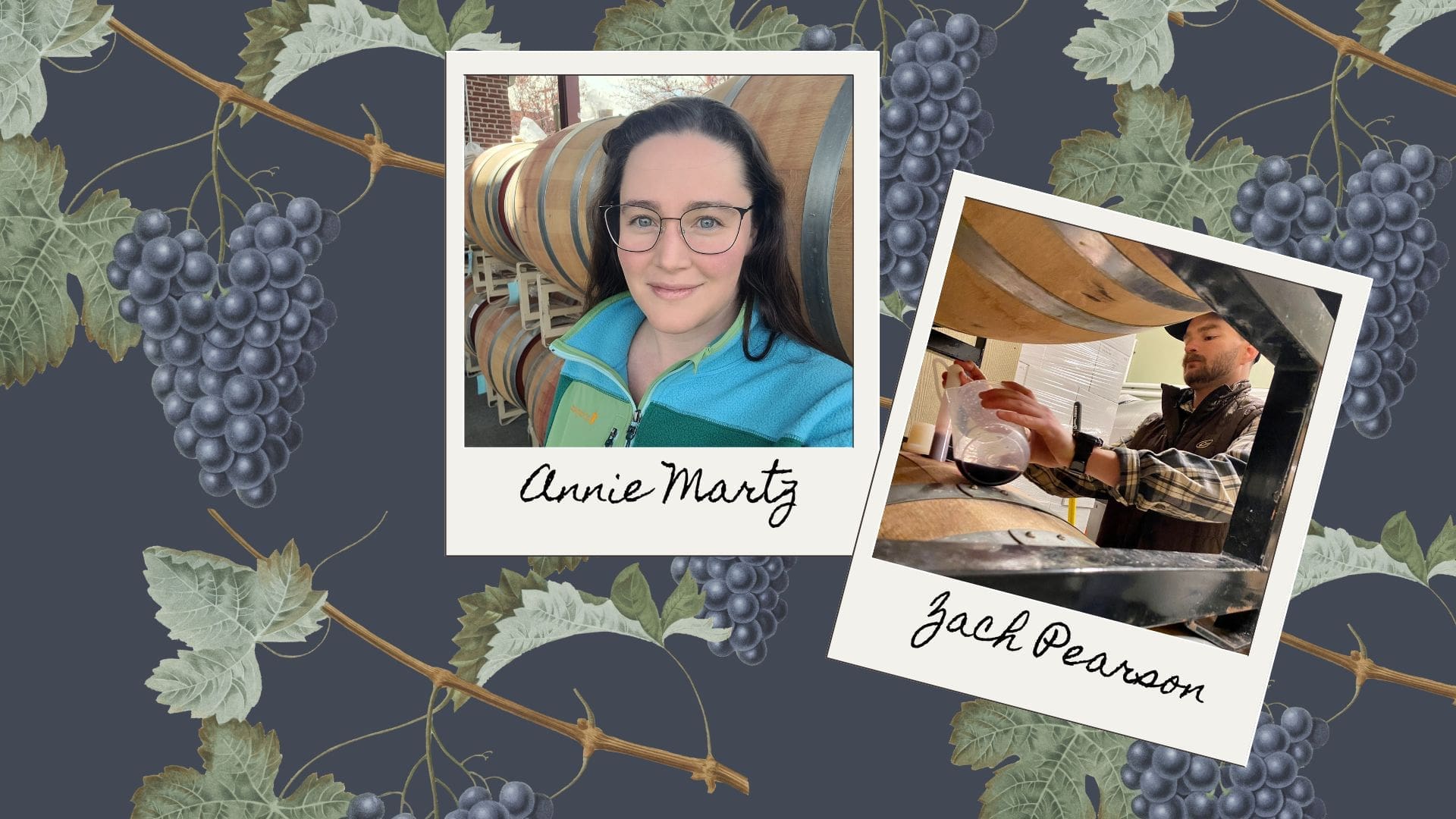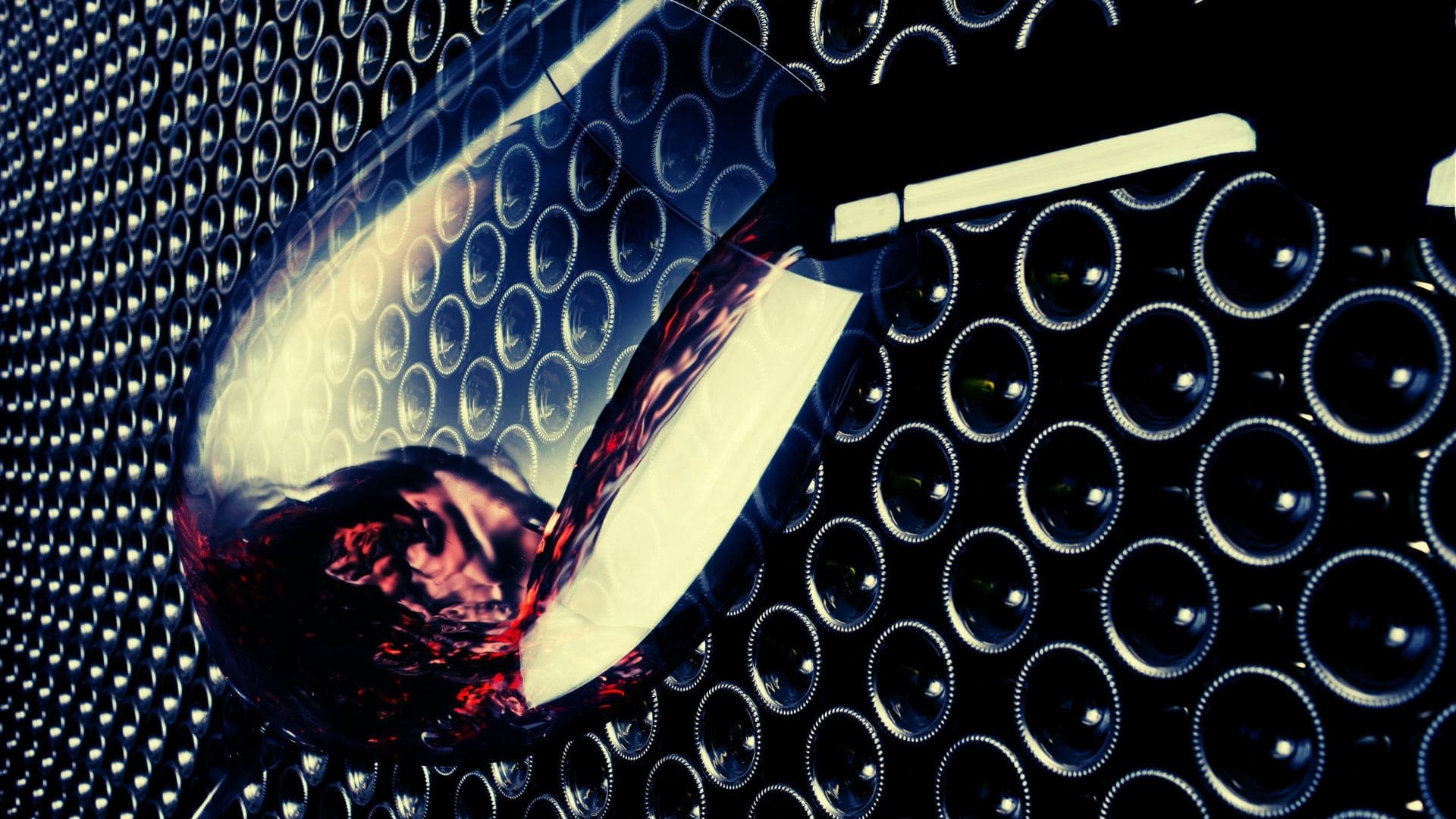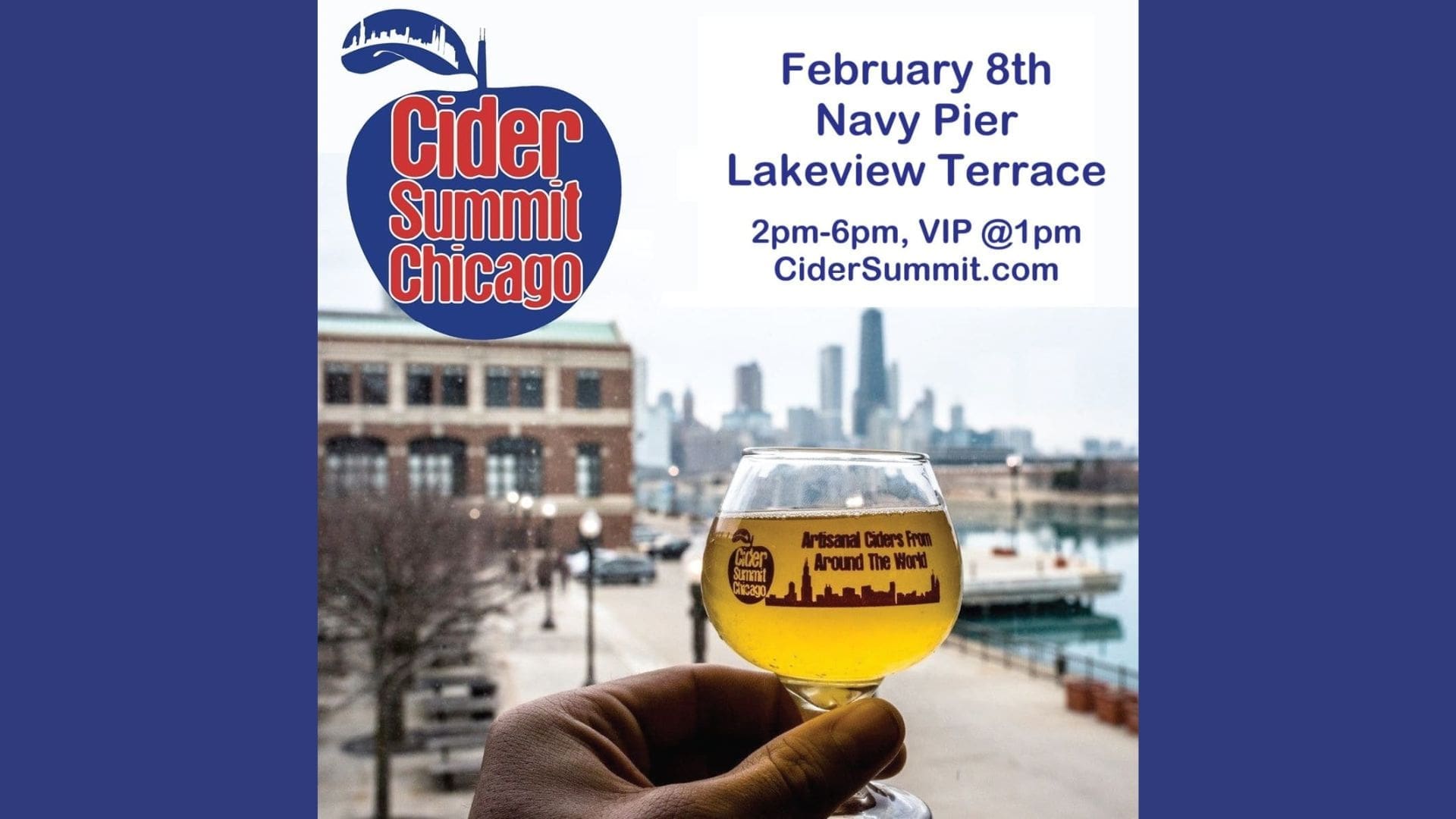Good news, wine lovers! Winemakers across Washington and Oregon are sharing positive reports about the 2024 wine grape harvest. This week, we dive into Washington’s vintage—what growers and producers are saying about the season and what to expect in the bottle. Stay tuned next week as we turn our attention to Oregon.
Everyone loves a good comeback story. 2024 didn’t start off so well, with spring coming on late, cool and wet. But by June, the weather in Eastern Washington, where the Red Mountain and Walla Walla Valley AVAs are located, had returned to its normal self, with ample balmy days, often verging on too hot, but reprieved by cool nights to strike a perfectly poised balance. All things considered, winemakers are verily stoked about the quality of the fruit for both red and white wine grapes they harvested this year.
“Expect powerful and ripe wines which retain a high degree of freshness,” said Tyler Williams, third-generation winemaker at Kiona Vineyards in the Red Mountain AVA.
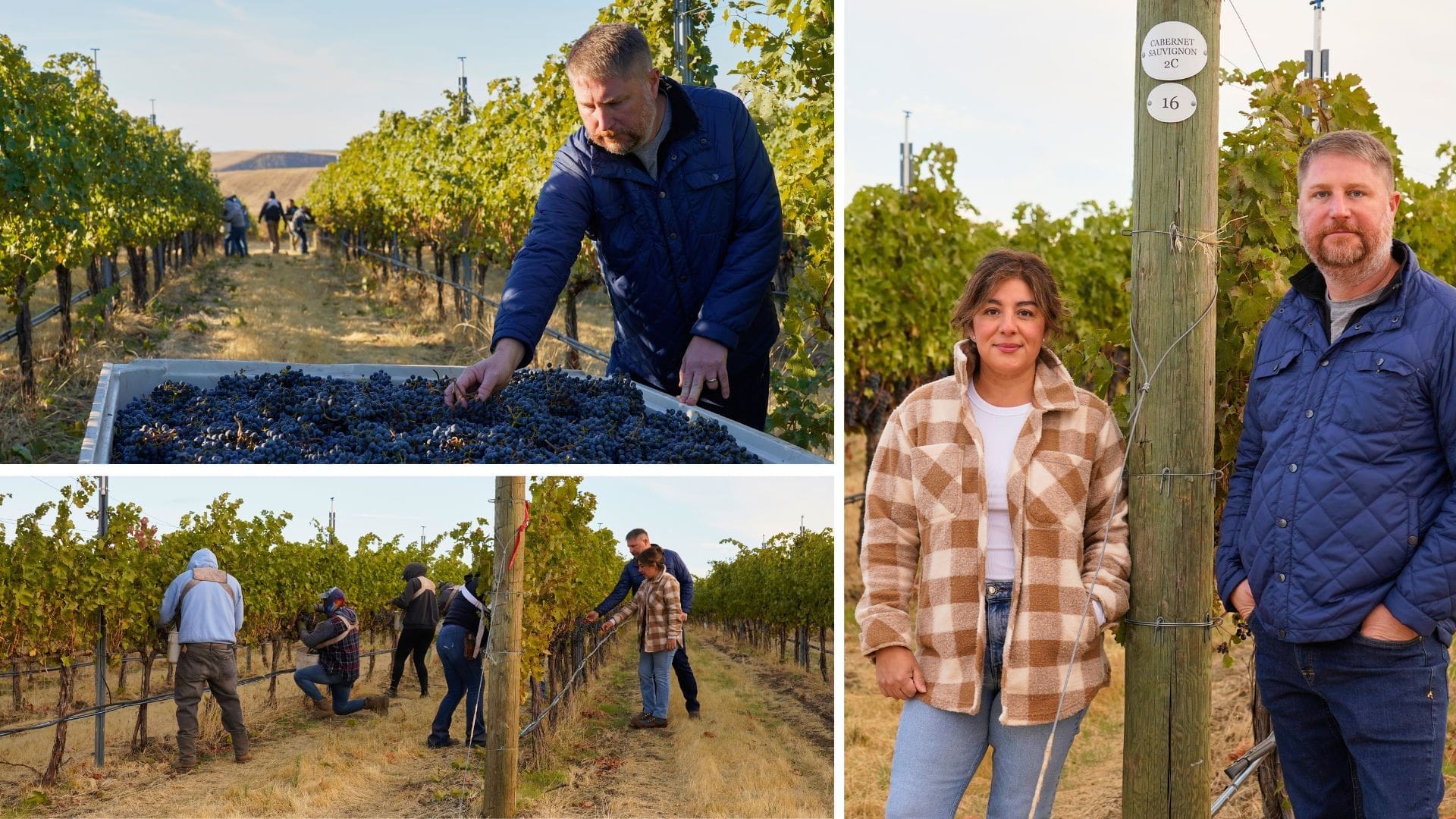
Abeja | Walla Walla Valley
Abeja winemakers Dan Wampfler and Amy Alvarez-Wampfler are two of Washington’s finest. Dan began his career with Ste. Michelle Wine Estates; Amy at Columbia Crest, where the couple’s professional and personal lives crossed. Since joining Abeja in January 2016, Dan and Amy have combined their winemaking talents and love for one another to create wines that exemplify meticulous viticultural practices and masterful blending. Located on a beautiful farmstead in the foothills of the Blue Mountains, the winery and luxury inn provide an idyllic setting for making great wine. (All photos were taken at Skysill Estate Vineyard, located a mile from the winery in the Mill Creek area on the east side of the Walla Walla Valley. Abeja planted the vineyard in 2016.)
Sip: What can people expect from your 2024 vintage, and why?
Dan Wampfler: 2024 was another stellar vintage. It’s early, but the whites are wonderfully aromatic with plenty of fresh, bright fruit characters. Reds are beautifully balanced, with ripe fruit flavors. We are very excited about these wines. I expect this to be a collector’s year.
Sip: In general, was there anything special, notable or different about the 2024 harvest compared to past harvests — in terms of the weather, harvest crew, supply chain, your customer base, etc.?
DW: An irregular ripening pattern kept us on our toes in 2024. In most years, there is an even progression to how and when varieties and vineyards ripen. We usually pick Connor Lee Chardonnay first, then Mill Creek Chardonnay, followed by Merlot, Syrah and so on. In 2024, the ripening sequence wasn’t predictable, partly because 2023 winter damage impacted crop loads across the state, so Amy and I were out in the vineyards more frequently than usual, tasting fruit to make precise picking decisions.
Amy Alvarez-Wampfler: This is also the first year we didn’t have to make a picking decision because of a weather event. Sometimes, you have to rush picking because rain is coming or a frost is on the way. That wasn’t the case in 2024. We harvested every block precisely at the ideal moment, and the pacing was such that there were no logistical challenges on the crush pad.
Sip: What was the best/highest point of the harvest? Were there any low/bad times? Was there a special event or occasion that made this past harvest particularly memorable?
AAW: Mother Nature cooperated across the board. Everything went smoothly. We have a seasoned crew that gets along great, puts safety first, and is dedicated to quality every step of the way. We couldn’t have asked for anything better!

Kiona | Red Mountain AVA
Celebrating its 50th anniversary, Kiona, is the dean of the Red Mountain AVA. Third-generation winemaker Tyler Williams, follows in the footsteps of family patriarch John Williams, who planted the first vineyard on this dusty slope in 1975. Kiona currently grows 20 different cultivars, comprising 272 planted acres across five distinct Red Mountain vineyards. “The first plantings of Chardonnay, Riesling and Cabernet Sauvignon, shortly followed by Lemberger, Merlot and Chenin Blanc, helped cement Red Mountain — and, to a greater extent, Washington state — as a region capable of making world-class wines,” says Williams.
Sip: What can winelovers expect from your 2024 vintage, and why?
Tyler Williams: The 2024 vintage was widely appreciated from both growers and winemakers. On Red Mountain, we had an average to warm-average growing season, tracking about 9% warmer than the historical 28-year average, though still cooler than the 2023 vintage. Consistently cool nights throughout the growing season and a moderate October allowed vintners to leverage both ripeness and acidity in their favor. 2024 will go down in the books as a benchmark for quality and varietal character. Expect powerful and ripe wines which retain a high degree of freshness.
Sip: In general, was there anything special, notable or different about the 2024 harvest compared to past harvests — in terms of the weather, harvest crew, supply chain, your customer base, etc.?
TW: With an average crop load, a moderate October without severe frost allowed winemakers to harvest well into autumn, allowing long hang times for many Cabernet vineyards. This period, with warm-ish days and cool nights, resulted in superb Cabernets from 2024.
Sip: What was the best/highest point of the harvest? Were there any low/bad times? Was there a special event or occasion that made this past harvest particularly memorable?
TW: With a new vintage brings new opportunities to experiment. Some of the most exciting moments have been tasting wines from new vessels and refining our winemaking technique to create unique products. 2024 afforded us the opportunity to use several new winemaking tools, including stoneware jars to texture whites and purpose-built fermentation barrels to macerate and extract very tannic red wines.

L’Ecole Nº 41 | Walla Walla Valley
Winemaker Marcus Rafanelli is a Seattle native and 2008 graduate of the Walla Walla Community College (WWCC) Institute for Enology and Viticulture program. While at WWCC, he worked as a harvest intern at L’Ecole N° 41. When he later returned to Walla Walla in 2016, Rafanelli took the role of Instructional Technician at WWCC and Cellarmaster at College Cellars. In 2019, he rejoined L’Ecole. Named after the 1915 schoolhouse that is the winery’s tasting room and headquarters, L’Ecole is a signature Walla Walla winery.
Sip: What can people expect from your 2024 vintage, and why?
Marcus Rafanelli: The quality is outstanding, with ideal balance, color extraction, fruitfulness, higher acidity and overall structure. The 2024 growing season was healthy and moderately warm, allowing vines to recover from winter cold better than expected, resulting in normal yields in most locations. A warm spring and hot summer were followed by nearly perfect harvest weather, with temperatures cooling as harvest began. The prolonged hang time led to exceptional fruit quality, with wonderful balance, crisp acidity and robust fruit expression.
Sip: In general, was there anything special, notable or different about the 2024 harvest compared to past harvests — in terms of the weather, harvest crew, supply chain, your customer base, etc.?
MR: A mid-January freeze event brought sub-zero temperatures for several days. Without an inversion, higher-elevation vineyards surprisingly showed more bud damage than lower-lying ones. Most growers pruned to leave extra buds, creating uncertainty about how the vines would recover. The warm, dry spring helped resilient vines rebound, pushing more buds than anticipated. Additional pruning and aggressive shoot thinning were necessary. A slightly cooler May extended the period from bud break to bloom. Near-perfect weather during bloom set a healthy crop, though some sites exposed to lower temperatures had reduced yields. In 2024, we saw fewer delays in major West Coast ports so we were able to order barrels and supplies and get them delivered in a timelier manner.
Sip: What was the best/highest point of the harvest? Were there any low/bad times? Was there a special event or occasion that made this past harvest particularly memorable?
MR: The highlight of the harvest is always the first and last fruits. The first fruit brings excitement for what’s ahead, while the last fruit signifies the completion of a successful season. We were fortunate to have fantastic weather in September and October, which might often go unnoticed, but for winemaking, it was crucial. This beautiful stretch of weather allowed us to take our time with the harvest, ensuring the highest quality of our produce.

Tranche | Walla Walla Valley AVA
Winemaker Spencer Williams has been a member of Tranche’s production team since 2012. He grew up on Vashon Island in the Puget Sound AVA, the only certifiably cool-climate appellation in Washington. He studied winemaking at Central Washington University in Ellensburg, Washington, which flies largely under the radar yet is the second-largest wine region in the United States, second only to California, with over 50,000 acres of grapevines and 900 wineries. The Tranche brand was founded by Michael and Lauri Corliss, namesake of the ultra-premium Corliss label, along with Secret Squirrel and San Juan Vineyard.
Sip: What can people expect from your 2024 vintage, and why?
Spencer Williams: The Walla Walla Valley experienced a winter freeze in January 2024 that initially set a somber tone for the rest of the vintage. While our most cold sensitive varieties like Merlot and Cinsaut weren’t able to bear any crop, the naturally reduced yield in the remaining blocks of our Blue Mountain Estate gave a balanced crop load and great concentration in the fruit. Our initial predictions showed a potential loss of 70% or more across the vineyard, but by harvest time we were only a bit below our normal yield targets and showing fruit with exceptional quality. The growing season of 2024 felt like a rollercoaster of emotions and expectations, but in the end our yield was still exceptional — that really speaks to the resilience of the vines.
Sip: In general, was there anything special, notable or different about the 2024 harvest compared to past harvests — in terms of the weather, harvest crew, supply chain, your customer base, etc.?
SW: The weather at harvest was nearly perfect. Warm and dry conditions through September and October let each variety fully ripen at its own pace. Persistent acidity and long hang time on the vine will give these 2024 wines depth, freshness, and a very long life in the cellar.
Sip: What was the best/highest point of the harvest? Were there any low/bad times? Was there a special event or occasion that made this past harvest particularly memorable?
SW: The highlight of harvest was bringing in a block of Grenache that, earlier in the year, we had written off to bear fruit in 2024. Apart from pruning, shoot positioning and spraying, those vines did not get much attention that season, but following veraison we discovered this small, but pristine crop of fruit. It was one of those moments when nature and terroir come together to make something perfect, and as winegrowers we just needed to stay out of the way. We’re really excited about that wine.

